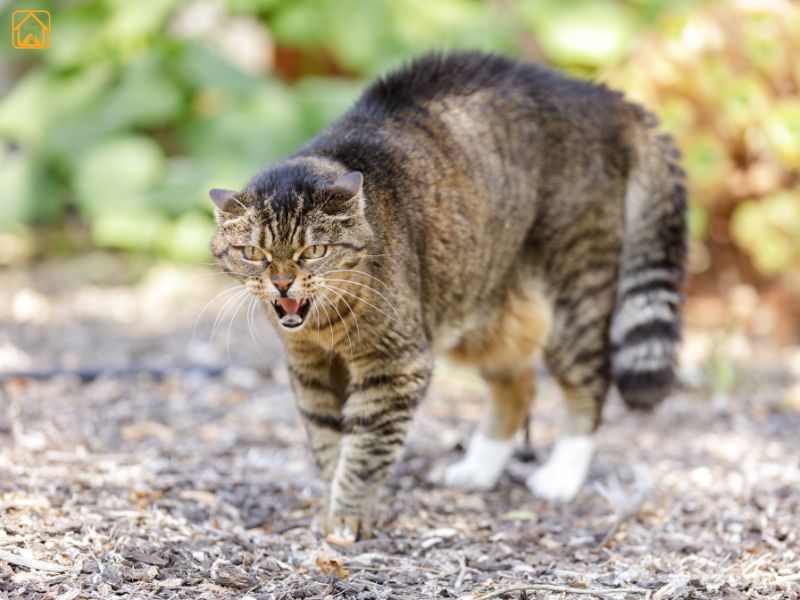Whether it’s fear, pain, territorial behavior, or something else, understanding the root of the cat aggression is the first step to solving it. In this guide, we’ll walk through why cats act aggressively and what you can do to help them feel safe, secure, and back to their usual loving selves.
Understanding Cat Aggression: What Is It and Why Does It Matter?
Cat aggression is more than just the occasional hiss or swat. It’s any hostile or threatening behavior, biting, scratching, chasing, or attacking, directed at people, other cats, or animals. Aggression in cats can result in injuries, broken trust, and sometimes, heartbreaking decisions if things go too far. It’s the second most common feline behavior issue after house soiling, and it affects cats of all ages, breeds, and backgrounds.
Why does it matter? Because aggression is often a sign that something is wrong, maybe your cat is in pain, anxious, or scared. And if left unaddressed, aggressive behavior can escalate, putting both pets and people at risk.
I remember a friend’s cat who started biting out of nowhere; it turned out she had dental pain. Once treated, her sweet personality returned. Recognizing and addressing cat aggression early can rebuild trust, prevent injury, and strengthen the bond you share with your feline friend.
Recognizing the Signs of Aggression in Cats

Not every swat or growl means full-blown aggression, but being able to spot the signs helps you react before things get out of hand. Cats are masters of subtle communication, so sometimes the warning signs are easy to miss. Here’s what to watch for:
- Body posture: Arched back, puffed-up (bottle-brush) tail, or crouched low to the ground
- Ears: Flattened against the head or swiveling backward
- Eyes: Dilated pupils, intense staring
- Vocalizations: Growling, hissing, spitting, or yowling
- Tail: Lashing, twitching, or held straight up with fur standing on end
- Physical actions: Swatting, biting, scratching, chasing, or blocking pathways
Sometimes, aggression signs in cats show up as subtle tension, tense muscles, whiskers pulled forward, or freezing in place. Playful roughhousing can look similar, but aggression is usually more intense, sudden, and paired with other warning cues. Ever tried petting your cat and suddenly got nipped? That’s often petting-induced aggression, and it’s surprisingly common.
Common Causes of Cat Aggression (Including Sudden Aggression)
So, why do cats get aggressive? The causes are as varied as cats themselves, but some of the most common triggers for aggression in cats include:
- Fear or anxiety, new people, animals, loud noises, or unfamiliar environments
- Pain or illness, arthritis, dental disease, neurological issues, or infections
- Territorial disputes, especially after a new pet, baby, or even furniture enters the home
- Redirected aggression, your cat is upset by something (like an outdoor cat) and lashes out at whoever is nearby
- Play aggression, especially in kittens and young cats who weren’t well socialized
- Petting-induced aggression, some cats get overstimulated and bite or scratch when they’ve had enough
- Maternal aggression, queens protecting their kittens
- Hormonal changes, such as a female cat suddenly aggressive after spaying, or males reaching social maturity
Sudden aggression in cats often points to an underlying medical issue or a major change in their environment. If your usually gentle cat is suddenly aggressive, don’t shrug it off. Ask yourself, “Has anything changed recently?” or “Could my cat be in pain?”
Types of Aggression in Cats: From Play to Territorial
Play Aggression
Common in kittens and young cats, play aggression often looks like stalking, pouncing, biting, and scratching, sometimes directed at people. It’s how kittens learn to hunt, but it can be rough if not guided properly. I once had a foster kitten who’d ambush my feet under the covers; cute at first, but those little teeth hurt!
Fear or Defensive Aggression
If a cat feels cornered or threatened, they may hiss, spit, crouch, and lash out to protect themselves. Defensive aggression is about self-preservation, not hostility.
Territorial Aggression
Cats are naturally territorial. A new animal or person can trigger guarding, spraying, chasing, or even fighting. This is often seen when introducing new cats or after one cat returns from the vet (non-recognition aggression).
Redirected Aggression
This sneaky type happens when a cat gets agitated by something they can’t reach, like seeing a stray cat through the window, and redirects that anger to a nearby cat or person.
Petting-Induced Aggression
Some cats enjoy petting only up to a point. When overstimulated, they may bite or scratch without warning. Watch for tail lashing, skin twitching, or flattened ears as cues to stop.
Maternal, Status-Induced, and Idiopathic Aggression
Mother cats may become aggressive when protecting kittens. Some cats try to establish dominance (status-induced), while others show sudden, unexplained (idiopathic) aggression. The latter may require a vet’s help to sort out.
Cat Aggression Toward Humans vs. Other Cats vs. Dogs
Not all cat aggression looks the same. Some cats are only aggressive toward humans like swatting hands during petting, while others target fellow cats or even dogs in the home. Aggression in cats toward humans may be triggered by fear, pain, or overstimulation. Aggression in cats toward other cats often revolves around territory, hierarchy, or redirected frustration. Cat aggression towards dogs is less common, but when it happens, it’s usually about territory or fear.
Each scenario needs a slightly different approach. For example, aggression between cats might require careful reintroduction, while aggression toward humans often involves behavior modification and environmental changes.
Medical and Behavioral Triggers: When to See a Vet
Medical Triggers of Cat Aggression
If your cat’s aggression is sudden or unusual, it may be caused by health issues. Look out for:
- Pain or illness: Cats in pain may lash out. Dental disease, arthritis, or internal injuries can cause discomfort.
- Hyperthyroidism: This common condition in older cats can lead to restlessness, irritability, and aggression.
- Infections: A hidden infection or fever may make your cat feel unwell and more reactive.
- Neurological issues: Brain-related problems can affect your cat’s mood and behavior.
- Sudden behavior change: If aggression appears out of nowhere, always start with a vet visit to rule out medical causes.
Behavioral Triggers of Cat Aggression
If your vet finds no medical issues, consider emotional or environmental triggers:
- Stress or anxiety: Big changes like moving homes, loud noises, or unfamiliar visitors can trigger aggression.
- New pets or people: Your cat might feel threatened or territorial, especially around other animals.
- Disruption in routine: Even small changes like feeding time or furniture rearrangement, can cause stress.
- Lack of enrichment: Boredom or frustration may lead to lashing out. Cats need playtime and mental stimulation.
- Past trauma: Rescue cats may show fear-based aggression due to negative past experiences.
Tip: If you’re unsure what’s behind the aggression, speak to a certified feline behaviorist. They can help identify the root cause and guide you toward a safe, calm solution.
How to Stop and Manage Cat Aggression: Step-by-Step Strategies
Step 1: Identify the Trigger
Keep a diary of aggressive incidents. Note the time, place, people or pets involved, and what happened just before the aggression. Patterns often emerge, maybe your cat reacts when startled, or only after seeing another cat outside.
Step 2: Rule Out Medical Causes
Always check with your vet first, especially if the aggression is new or severe. Pain and illness are common culprits.
Step 3: Manage the Environment
- Provide plenty of hiding spots and vertical spaces (cat trees, shelves) so cats can escape or observe quietly.
- Use pheromone diffusers (like Feliway) to help reduce tension.
- Keep resources (litter boxes, food bowls, beds) separate for each cat.
- Block visual access to outdoor cats if redirected aggression is an issue.
Step 4: Redirect Energy and Build Positive Associations
- Schedule daily interactive play sessions using wand toys or feather chasers to redirect play aggression.
- Reward calm, relaxed behavior with treats or gentle praise.
- Never punish aggressive behavior, it can increase fear and make things worse.
Step 5: Gradual Desensitization and Counter-Conditioning
If your cat is aggressive toward a specific person or another pet, use slow, controlled reintroductions. Start at a distance and reward calm behavior, then gradually decrease the distance over days or weeks. Patience is key.
Step 6: Know When to Separate
If fights break out, separate cats or remove yourself from the situation. Never use your hands to break up a cat fight, use a barrier like a pillow or a large piece of cardboard for safety.
Treatment Options and Medications for Aggressive Cats
Some cases of cat aggression need more than just environmental tweaks. If your cat’s aggression is persistent, severe, or dangerous, your vet might recommend:
- Behavioral therapy: A certified feline behaviorist can create a custom training plan based on your cat’s unique triggers and needs.
- Pheromone products: Diffusers and sprays like Feliway can help create a calm space by mimicking natural cat scents that signal safety.
- Calming supplements: Natural products like Zylkene, Solliquin, and calming probiotics can gently ease stress and tension without prescription meds.
- Prescription medication: In more serious cases, vets may recommend meds like gabapentin, fluoxetine (Prozac), or alprazolam. These are always given under veterinary guidance and paired with training.
Medication is not a quick fix, but it can help break the cycle of aggression so that training and positive experiences can work.
Preventing Cat Aggression: Socialization, Environment, and Training Tips
Stopping cat aggression before it starts is all about creating a calm, happy life for your cat. Whether you’re raising a kitten or helping an adult cat adjust, small steps can make a big difference.
Here are some proven tips to help prevent aggressive behavior:
- Socialize early and gently: Expose kittens to different people, sounds, pets, and experiences in a positive way to build confidence.
- Create an enriching environment: Provide scratching posts, climbing trees, toys, and cozy hiding spots to keep your cat mentally and physically active.
- Stick to a daily routine: Cats feel safer when they know what to expect like regular meal times, play sessions, and quiet hours can all help.
- Watch for early warning signs: Tail flicking, ears back, hiding, or growling are all signs your cat may be stressed or overwhelmed.
- Spay or neuter your cat: This helps reduce hormone-driven aggression and can lead to a calmer, more content pet.
Above all, be patient. Training takes time, but with love and consistency, you can help your cat feel secure and peaceful at home.
FAQs About Cat Aggression
Why is my cat suddenly aggressive toward me?
Sudden aggression in cats often signals pain or illness. Sometimes, it’s stress from changes at home, new pets, or even something as simple as moving furniture. A checkup with your vet is the first step.
How can I tell the difference between play and real aggression in cats?
Playful cats may chase, pounce, or nibble gently, but their claws are usually retracted and their body language is relaxed. Aggressive cats have flattened ears, puffed-up tails, hissing, and tense muscles, and their attacks are more intense.
What should I do if my female cat is suddenly aggressive after spaying?
Some cats may react to the stress of surgery with temporary aggression. Give her time to recover in a quiet space, and contact your vet if the behavior continues for more than a week or seems severe.
Can certain breeds be more prone to aggression?
While breed plays a role, aggression can happen in any cat. Siamese and Abyssinian cats are sometimes mentioned as more assertive, but socialization and environment matter most.
How do I stop food aggression in cats?
Feed cats in separate areas to reduce competition. Avoid free-feeding if you notice tension, and reward calm behavior at mealtimes. Never physically intervene if a fight starts, use distractions instead.
Is medication safe for cats with aggression issues?
When prescribed and monitored by a veterinarian, medications like gabapentin or fluoxetine can be safe and effective. They should always be used alongside behavior modification, not as the only solution.
How can I safely break up a fight between my cats?
Never use your hands. Make a loud noise, toss a soft pillow, or place a barrier between them. Let them cool off in separate rooms. Reintroduce slowly and watch for warning signs before allowing them together again.
Conclusion
Dealing with cat aggression takes time, empathy, and a little detective work. But with patience and the right approach, you can help your cat feel safe and restore harmony at home.



